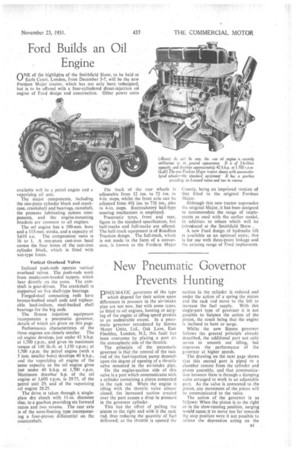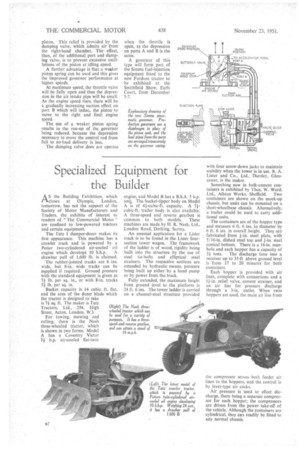New Pneumatic Governor Prevents Hunting
Page 35

Page 36

If you've noticed an error in this article please click here to report it so we can fix it.
DNEUMATIC governors of the type 1 which depend for their action upon differences in pressure in the air-intake pipe are not new, but with some types, as fitted to oil engines, hunting or surging of the engine at idling speed persists to an undesirable extent. In a pneumatic governor introduced by Simms Motor Units, Ltd., Oak Lane, East Finchley, London, N.2, this fault has been overcome by placing a port on the atmospheric side of the throttle.
The principle of the pneumatic governor is that the control of the rack rod of the fuel-injection pump depends upon the degree of opening of a throttle valve mounted in the air-intake pipe.
On the engine-suction side of this valve is a port which communicates with a cylinder containing a piston connected to the rack rod. When the engine is idling with the throttle valve almost closed, the increased suction created over the port causes a drop in pressure lit the governor cylinder.
This has the effect of pulling the piston to the right and with it the rack rod, thus reducing the quantity of fuel delivered; as the throttle is opened the
suction in the cylinder is reduced and under the action of a spring the piston and the rack rod move to the left to
increase the fuel supply. With this single-port type of governor it is not possible to balance the action of the piston, the result being that the engine is inclined to hunt or surge.
Whilst the new Simms governor follows the general principle already described, the additional port not only serves to smooth out idling, but improves the performance of the governor at higher speeds.
The drawing on the next page shows that this second port is piped to a chamber remote from the cylinder and piston assembly, and that communication between them is through a damping valve arranged to work in an adjustable port. As the valve is connected to the piston, any movement of the piston will be communicated to the valve.
The action of the governor is as follows: When the piston is to the right or in the slow-running position, surging would cause it to move too far towards the stop position were it not possible to relieve the depression acting on the
piston. This relief is provided by the damping valve, which admits air from the right-hand chamber. The effect, then, of the additional port and damping valve, is to prevent excessive oscillations of the piston at idling speed.
A further advantage is that a weaker piston spring can be used and this gives the improved governor performance at higher speeds.
At maximum speed, the throttle valve will be fully open and thus the depression in the air intake pipe will be small. As the engine speed rises, there will be a gradually increasing 'suction effect on port B which will induc, the piston to move to the right and limit engine speed. The use of a weaker piston spring results in the run-up of the governor being reduced, because the depression necessary to move the control rod from full to no-load delivery is less.
The damping valve does not operate when the throttle is open, as the depression on ports A and B is the same.
A governor of this type will form part of the Simms fuel-injection equipment fitted to the new Fordson tractor to be exhibited at the Smithfield Show, Earls Court, from December 3-7.












































































